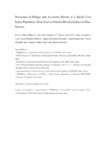Mostrar o rexistro simple do ítem
Prevalence of Fatigue and Associated Factors in a Spinal Cord Injury Population: Data from an Internet-Based and Face-to-Face Surveys
| dc.contributor.author | Cudeiro-Blanco, Javier | |
| dc.contributor.author | Onate-Figuérez, Ana | |
| dc.contributor.author | Soto-León, Vanesa | |
| dc.contributor.author | Avendaño-Coy, Juan | |
| dc.contributor.author | Mordillo-Mateos, Laura | |
| dc.contributor.author | Brocalero-Camacho, Ángela | |
| dc.contributor.author | Esclarín-Ruz, Ana | |
| dc.contributor.author | Rotondi, Mario | |
| dc.contributor.author | Aguilar, Juan | |
| dc.contributor.author | Arias, Pablo | |
| dc.contributor.author | Oliviero, Antonio | |
| dc.date.accessioned | 2022-02-17T11:28:03Z | |
| dc.date.available | 2022-02-17T11:28:03Z | |
| dc.date.issued | 2017-08-01 | |
| dc.identifier.citation | Cudeiro-Blanco J, Onate-Figuérez A, Soto-León V, Avendaño-Coy J, Mordillo-Mateos L, Brocalero-Camacho A, et al. Prevalence of Fatigue and Associated Factors in a Spinal Cord Injury Population: Data from an Internet-Based and Face-to-Face Surveys. J Neurotrauma. 2017;34(15):2335-2341 | es_ES |
| dc.identifier.issn | 0897-7151 | |
| dc.identifier.uri | http://hdl.handle.net/2183/29808 | |
| dc.description.abstract | [Abstract] Fatigue has a profound impact on patients with spinal cord injury (SCI), but only limited treatments are available. The aim of this study was to determine the prevalence of fatigue in SCI and its association with clinical and demographic factors. We used an internet-based survey and a face-to-face interview to estimate the prevalence of fatigue in a SCI population. Fatigue was measured using the Fatigue Severity Scale (FSS). Clinically significant fatigue was defined as FSS scores greater than or equal to four. A total of 253 participants with SCI were included in the study. Clinically significant fatigue was present in one third of our sample. There was no relationship between fatigue and injury level or completeness. We found significant correlations between depression, pain, and level of injury. The relation of fatigue with completeness of injury and spasticity is less clear. Moreover, the online survey and the standard face-to-face interview showed similar results concerning fatigue evaluation. Several factors may contribute to fatigue, however. Future studies should be conducted to clarify which are the most relevant ones and, if possible, to determine which factors are modifiable. | es_ES |
| dc.language.iso | eng | es_ES |
| dc.publisher | Mary Ann Liebert | es_ES |
| dc.relation.uri | https://doi.org/10.1089/neu.2016.4950 | es_ES |
| dc.rights | This is the original submission version (pre-peer review) of the article which has now been formally published in final form at Journal of Neurotrauma. This original submission version of the article may be used for non-commercial purposes in accordance with the Mary Ann Liebert, Inc., publishers’ Self-Archiving Terms and Conditions. | es_ES |
| dc.subject | ASIA | es_ES |
| dc.subject | SCI | es_ES |
| dc.subject | Fatigue | es_ES |
| dc.subject | Tetraplegia | es_ES |
| dc.title | Prevalence of Fatigue and Associated Factors in a Spinal Cord Injury Population: Data from an Internet-Based and Face-to-Face Surveys | es_ES |
| dc.type | info:eu-repo/semantics/article | es_ES |
| dc.rights.access | info:eu-repo/semantics/openAccess | es_ES |
| UDC.journalTitle | Journal of Neurotrauma | es_ES |
| UDC.volume | 34 | es_ES |
| UDC.issue | 15 | es_ES |
| UDC.startPage | 2335 | es_ES |
| UDC.endPage | 2341 | es_ES |
Ficheiros no ítem
Este ítem aparece na(s) seguinte(s) colección(s)
-
GI-NEURO - Artigos [132]






